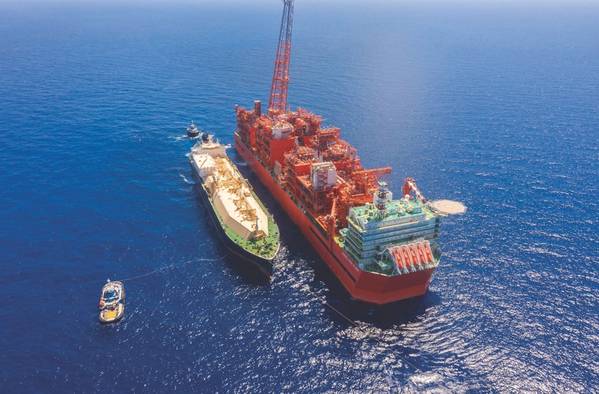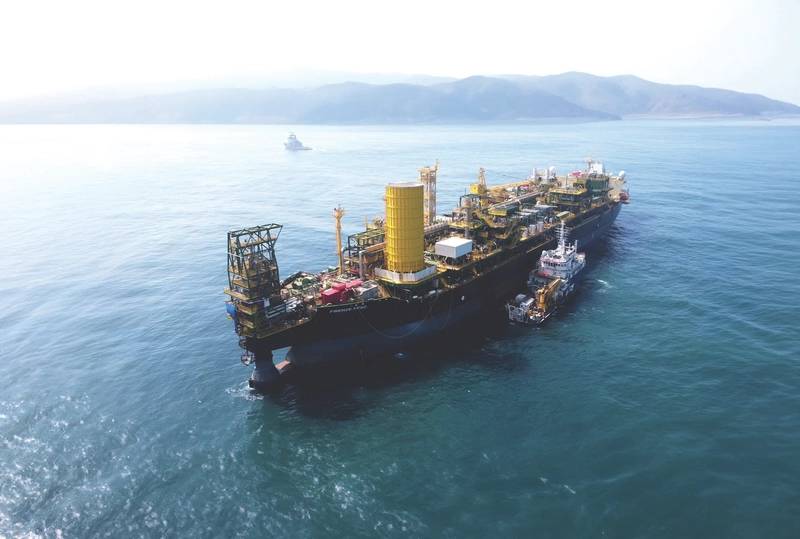
Offshore energy is on a growth trajectory. Rystad Energy wrote in February 2024 that upstream oil majors were diving in to deeper waters. “Despite tightened budgets, frontier drilling is fueling optimism for a productive year, particularly deepwater projects in the Atlantic Margin, Eastern Mediterranean and Asia,” Rystad wrote, noting that “the trend suggests a significant push toward deeper waters, with more than half of the awarded blocks targeting deepwater or ultra-deepwater reserves.”
This focus is reflected in global exploration activity, with Rystad analysts predicting approximately 50 more deepwater and ultra-deepwater exploratory wells this year compared to 2023.
“Frontier and underexplored basins, teeming with hidden potential, offer the promise of substantial untapped resources,” Rystad wrote. “Unlike mature basins where exploration yields smaller, scattered finds, these new areas hold the allure of large, geographically concentrated prospects.”
The “Golden Triangle” (bounded by the U.S. Gulf, Brazil and Nigeria) continues to dominate the offshore side of oil and gas exploration and production, but diversification of geographies, into the new areas looms large on planners’ charts. In Africa, hydrocarbon production generally, and offshore oil and gas in particular, play key roles in countries’ development plans. As previously unexploited oil and gas plays are developed, fine tuning of business models is complementing the march into the new geographies. FLNG Gimi outbound from Singapore.
FLNG Gimi outbound from Singapore.
Image courtesy Golar LNG
New Projects, New Promise
One cooperative effort hopes to produce first gas during 2024. BP and Kosmos Oil, working in conjunction with the national oil companies of Senegal, and their counterparts in neighboring Mauritania, have been developing the Greater Tortue Ahmeyim project. The project is all about innovative production and transportation. The gas, from subsea production wells roughly 120 km offshore at a depth of 2,850 meters, will be processed aboard the FPSO N999 Tortue (completed in early 2023 at COSCO’s yard in Qidong, China) then piped to the Golar LNG owned Gimi, an FLNG (converted from a 1976 built LNG tanker at Seatrium in Singapore) moored 10 km offshore.
In a crude oil production project set come online in 2024, the Australian gas developer Woodside Energy will deploy the FPSO Léopold Sédar Senghor at the Sangomar field, approximately 100 km offshore Senegal. The FPSO will be fed by two dozen subsea wells, in waters depths of around 1,000 meters. The vessel (with conversion from a VLCC completed in China at a COSCO yard, followed by pre-commissioning work in Singapore by Seatrium, with MODEC handling topside integration), will be capable of processing 100,000 bbl day of crude – anticipating European refineries being the likely buyers – with a storage capacity of 1.3 million bbl.
Woodside, with a $60 billion balance sheet at end 2022, post the BHP transaction, has placed the overall cost of the project’s Phase 1 to around $5.2 billion (versus the $4.1 billion originally budgeted circa 2020), with Woodside noting that COVID-related construction deficiencies on the FPSO had brought about a need for “remedial work” that was undertaken in Singapore.
Annual reports from Woodside peg its capital expenditures on Sangomar at $1 billion in 2021 and $1.034 billion in 2022 – significantly more than half of the company’s CapEx spend during that year. The capital stack buttressing Sangomar (with Woodside holding an 82% stake) has benefitted from a loan of $54 million from the multinational infrastructure capital provider Africa Development Bank.
Italian energy behemoth ENI has been active in offshore Africa.
In late Summer, 2023, ENI began crude production at its Baleine field, offshore Ivory Coast (southeast of Abidjan, using FPSO Baleine , previously named Firenze, originally an Aframax tanker Betatank II, built in 1989, converted at Dubai Drydocks World for Saipem and acquired by ENI in 2013).
Initially handling up to 15,000 bbl/day of oil and around 25 Mscf/day of gas – to be delivered onshore by a newly constructed pipeline – its capacity will be ramped up to up to 150,000 bbl/day of oil and 200 Mscf/day of gas in mid-decade. Work is beginning on a second FPSO/ FSO combination at Baleine, with Norwegian subsea specialist DOF awarded a contract for installation of seabed mooring systems and other tasks, including a flowline that will link the FPSO, with the storage tanker.
In Congolese waters, ENI is set to begin production, pegged at 3 million tons/year (tpy) from its Tango FLNG, with storage aboard the FSU Excalibur The FLNG, previously owned by Exmar before its sale to ENI, had previously been on charter to YPF in Argentina before a 2023 upgrade in Dubai at Drydocks World. Exmar, the Saverys-family controlled owner based in Antwerp, is putting the FSU (built in 2002) on 10 year charter to ENI- which says that a second FLNG is under construction and expected to commence production in 2025. Tungsten Explorer, 6th Generation Ultradeepwater drillship.
Tungsten Explorer, 6th Generation Ultradeepwater drillship.
Image courtesy Vantage DrillingA Shifting Triangle
As the Triangle changes its shape, Namibia, further south, is set to come on the scene as an offshore oil producer in the late 2020s; Shell and Total are currently involved in exploration efforts in the Venus Basin, with Chevron expected to enter the fray. As appraisal drilling progresses, a Total subsidiary exercised an option to extend its charter of the 6th generation DP3 semisubmersible Deepsea Mira (owned by John Fredriksen-linked Northern Ocean). Shell has a sister rig Deepsea Bollsta drilling in the nearby Orange Basin, expected to come off charter in mid-2024. Previously, the 7th generation drillship Maersk Voyager had been on to Total, with Vantage Drilling’s Tungsten Explorer presently on charter until mid-2025, with further options.
In adjacent waters farther east, Total is leading a group of partners including Qatar Energy, and Africa Energy, seeking to develop gas fields discovered in Brulpadda and Luiperd blocks within the Outeniqua Basin, with plans to process the gas (transmitted using existing infrastructure serving existing fields closer to shore) at a gas-to-liquids facility at Mossel Bay. Rystad, in its commentary, had opined that: “…discoveries such as Brulpadda and Luiperd in South Africa in 2019 and 2020 and Venus and Graff in Namibia, both in 2022, have led to the opening of new hydrocarbon plays.”
Elsewhere, a U.S. Department of Energy’s Energy Information Administration (EIA) December 2023 report explained that: “Mozambique has in recent years dealt with a sudden influx of militant attacks on areas close to export infrastructure. These security issues have resulted in the declaration of force majeure on the Mozambique LNG project, delaying the facility’s start date and the development of other LNG infrastructure projects.”
But there has been progress. In late 2022, ENI began exporting LNG of the Coral South floating liquefied natural gas project, where it is the operator and majority partner. The FLNG Coral Sul , drawing gas from six undersea wells, has the capacity to produce 3.4 million tpy. A second FLNG project, also in Mozambique’s Rovuma Basin, is reportedly in works, though no FID has been announced.
 FPSO Firenze- at ENI's Baleine project, offshore Ivory Coast.
FPSO Firenze- at ENI's Baleine project, offshore Ivory Coast.
Image courtesy ENI
Moving Energy
For the transport side, the new equipment and infrastructure configurations are complemented by financial structures that are variations of more conventional balance sheet funding. They keep the longer-term flavor and project-specific flavors that have characterized offshore investing, but move ownership to the Private Equity (PE) sphere, albeit with a different focus than previous on shipping investments. At the February, 2024 annual “HACC NACC” event in New York, Art Regan, CEO, Energos Infrastructure, an owner of LNG carriers, storage vessels, and importantly, floating storage and regasification( FSRU) capabilities, delved into backers’ financial rationale of its backers: the $14B Infrastructure division of PE-giant Apollo Global.
“I would say it’s predictable income. Using Apollo as a reference, the mandate has moved away from risk; they are more of a pension fund manager than a PE shop as we know them from 20 years ago.” Earlier rounds of PE investment in shipping companies – by Apollo and others – had looked to asset appreciation, with mixed outcomes. Regan, continuing, explained that suitable structures are “long-term income based” adding that “what we do is more terminal management than pure play shipping.”
Apollo now owns 100% of Energos Infrastructure, following a deal cemented in February, 2024 when New Fortress Energy (NYSE: NFE) an offshoot of the PE behemoth Fortress Investment) with Assets Under Management (AUM) of $46 billion in late 2023, sold a 20% stake that it held.
Energos represents a new breed of infrastructure provider, motivated by energy security concerns as well as the ongoing transition to fuels with lower carbon footprints. Energos Infrastructure actually came on the scene in the months after the 2022 disruptions in the movement of Russian gas into Europe, bringing in a fleet previously owned by Golar LNG Partners LP, and then transitioned into NFE before moving into the hands of Apollo. In the wake of reduced gas availability from Russia, Energos (which has chartering arrangements with NFE around six of its 13 vessels, with NFE dealing with the gas importers and exporters) was quick to deploy its FSRU Energos Igloo at Rotterdam to feed the Dutch power grid. Another FSRU, Energos Celsius, is being deployed at Barcarena in northern Brazil (after conversion at Seatrium in Singapore from a conventional LNG carrier) and will be fueling alumina production in addition to serving a power plant under construction. Nine of Regan’s company’s 13 vessels are described as FSRUs. In early 2024, two additional vessels, 174,000 cbm capacity acquired from Greek owner Dynagas (Procopiou), handling gas imports into Germany, were slated to join the fleet.
Talking about customers’ motivations for floating regasification using FSRU’s (which Art Regan described as “plug and play” in his HACC NACC remarks) rather than building land-side import terminals, he said, “They don’t have to go through the exercises of approval, permitting, etc. They can hire us for one, five, 10, hopefully 25 years, and always have the option to change that if it doesn’t work for their power grid.” Other owners participate in FSRU’s; another LNG carrier refitted for “regas” duty, Alexandroupolis, owned by Gastrade, with links to the Livanos controlled owner GasLog, has moved to a site offshore northern Greece after a 10 month conversion project, also at Seatrium.
The innovations in moving LNG are not all on the imports side, where FSRUs are becoming increasingly prevalent. In a recent LNG export deal, Energos Penguin, a vessel storing LNG for export after processing, is integral to the configuration at NFE’s Altamira, Mexico floating liquefaction facility, which has been built in the “FAST LNG” mold, on three platforms configured on jack-ups stationed in 10 miles offshore in the Gulf of Mexico, near Tampico.
The facility, dubbed FastLNG 1 – with modules for treatment, liquefaction and utilities – promises quicker deployment than extensive construction of an FLNG vessel. The Altamira installation will be treating gas originating in Texas, and then piped down to Mexico. After liquefaction, the LNG will be stored on the Energos vessel prior to shipment aboard internationally flagged LNG tankers to destinations expected to include Puerto Rico, where NFE has invested in a terminal for distributing gas on the island.  Fast LNG rendering.
Fast LNG rendering.
Image courtesy New Fortress Energy